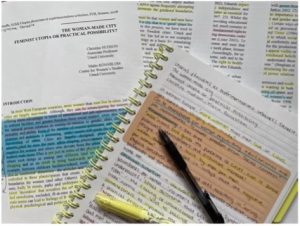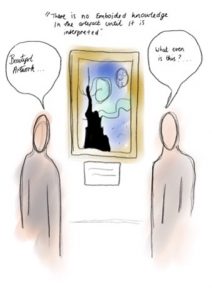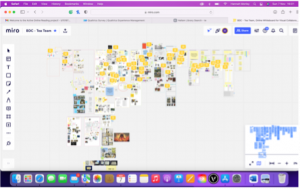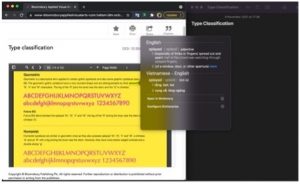The next in our series of posts on student practices and experiences of reading is from Linh Dao and Hannah Morley, MA students in Design at Sheffield Hallam University.
Surrounded by Design, designers are increasingly challenged to question design solutions by futurizing and speculating practices; an integral part of the design and research process (Tonkinwise, 2015). Design exists to tackle issues, which naturally change as society grows (Malpass, 2016), as our world is dependent on how design decisions affect society and the environment (Prado, 2014). To create these solutions, we need to be able to read effectively, a fundamental skill for students on all courses even though this is a small aspect of the entire design research process. We both are from design backgrounds, yet we both have very different approaches when it comes to reading.
Hannah’s Perspective

Anger, dismay, and failure, perfectly describes my relationship with reading, a skill that I definitely have a love and hate relationship with. The lack of consistency with the skill is a daily battle when it comes to problem-solving and creating concepts for designs. From a very young age, I have always struggled to engage with reading and English Literature in general which evitable was worsened by a lack of confidence and reaching key reading milestones later than my peers. Only recently, as I am studying for my masters, have I managed to sort out an effective approach to learning reading.

Pre-pandemic, my own practices would typically involve writing out notes from published material and annotating a notebook, avoiding digital readings of 10+ pages as my attention span cannot focus for that long. The shift to hybrid and online learning resulted in me adapting my approach. Over the past 18 months, I have found several ways to actively read online that work for me. I tend to print out text from online resources, annotating them to break down sentences, analysing as I go using a coloured guiding reading strip. This enables me to focus on each individual word as opposed to skim reading.

The environmental impact of all this printing does make me feel guilty, adding to the negative emotions surrounding reading. Recently, I have found that many tools online are starting to be inclusive by including a guiding reading strip, an option to change page colours, and /or annotation options which helps. I have used platforms such as Miro to collaboratively annotate and add links to online readings. However, despite this my most effective method of actively reading is taking quotes from a text, writing it out along with the reference and interpreting that into a drawing or some other creative outcome. I find I am better able to understand visual works and, when it comes to the research process, I tend to use a tablet and pencil to do this allowing me to add this creative outcome to the text, just like I would have done if I digitally annotated the text.
Linh’s Perspective
As an international student whose first language is not English, I am not entirely familiar with reading articles and books written in English. It takes much more time for me to fully comprehend the ideas and the thoughts of the author. When reading online, I always open a note app, using it together side-by-side with the original article/book and write my reflection on that article. I usually use a digital dictionary available in the notebook – with new words and grammar structures, I can look them up in the dictionary quicker. That is the reason I prefer reading online to reading physical books.
I usually read a book a couple of times to make sure that I fully comprehend the author’s ideas. In the first read, I will try to skim through the paragraphs and search for any new words. In this step, I will not try to understand every idea of the book. After finishing skimming, I will wait for a couple of days before reading it a second time, in which I will read each sentence and paragraph slowly and carefully, highlighting key ideas and thoughts. At this point, I have read the book at least twice, and then for the third time, I will make an entry into my journal.

Typically, my notes will include:
- A quick summary about the author
- The topic/theme of the book
- Some key takeaways from the book
- Rating the book between 1 and 10
- A brief reflection on my opinion.
I will get everything out of the book that I need to know. This method allows me to be really immersed in the book, rather than just skipping through the pages that can easily lead to neglecting to read some essential parts.
As you can see, we both have very different perspectives on digital reading, both have had our struggles and been on a journey to find what works for us best. It will be interesting to see if these perspectives are more typical of student approaches to research in the design sector!
References
Mäkelä, M. (2007). Knowing Through Making: The Role of the Artefact in Practice-led Research. Knowledge, Technology & Policy, 20(3), 157–163. https://doi.org/10.1007/s12130-007-9028-2
Malpass, M. (2016). Critical Design Practice: Theoretical Perspectives and Methods of Engagement. In The Design Journal: An International Journal for All Aspects of Design (3rd ed., Vol. 19, pp. 473–489). https://doi.org/10.1080/14606925.2016.1161943
Prado, L. (2014, February). Questioning the critical in speculative and critical design. (P. Oliveira, Ed.). Retrieved from https://medium.com/a-parede/questioning-the-critical-in-speculative-critical-design-5a355cac2ca4
Tonkinwise, C. (2015, August). Just Design: Being Dogmatic about Defining Speculative Critical Design Future Fiction. Retrieved from https://medium.com/@camerontw/just-design-b1f97cb3996f#.clxns15xo